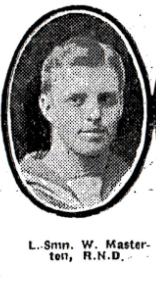Acting Leading Seaman William Low Masterton
 Clyde Z/3970, Drake Battalion
Clyde Z/3970, Drake Battalion
Royal Naval Division
killed in action 30th December 1917
aged 23
Thiepval Memorial
Pier and Face 1A.
son of Abram Masterton and Helen Whyte, Dundee
Genealogy
William Low Masterton was born in North William Street, Dundee, Scotland on 29 June 1894, the seventh child born to Abram Masterton, an agricultural labourer, later railway carter, and Helen Whyte who had married in Forfar in 1857. His service record identifies him as a footballer.
Further details of William and the extended family of Mastertons who can be traced back to the Forfar area of Forfarshire (now Angus) can be found at the following link.
His War
William enlisted into the Royal Naval Volunteer Reserve on 14th April 1915 and was drafted into the Mediterranean Expeditionary Force and joined Drake Battalion, part of the 1st Royal Naval Brigade in the 63rd (Royal Naval) Division on 21 September 1915. He suffered a debility from 12 October to 5 November 1915 and later caught influenza on 8 December 1916, by which time the battalion was in France. He was invalided to the UK on 16 December 1916. Drafted back to the British Expeditionary Force in March 1917, he rejoined Drake Battalion on 11th April until suffering a bullet wound to the left arm and being invalided home again on 21 July 1917. Drafted yet again, he rejoined Drake Battalion on 13 November 1917. This time for his final tour of duty.
He was killed on 30th December 1917, the day the division was fighting the action of Welsh Ridge, subsequent to the Cambrai operations. His records show that he was found dead on teh battlefield by the Germans.
William's rank fluctuated from Able-Bodied Seaman to Leading Seaman (on 23 May 1917), reverting to AB Higher Grade (on 17 October 1917), then Acting Leading Seaman (on 16 November 1917).
The curiosity of having Royal Navy personnel fighting on land arose because at the declaration of the war on 4 August 1914, there was a surplus of some 20-30,000 men of the reserves of the Royal Navy who would not find jobs on any ship of war. It was recognised that this was sufficient to form two Naval Brigades and a Brigade of Marines for operations on land. [The Long, Long Trail] The 63rd (Royal Naval) Division was one of the first to mobilise to the defence of Antwerp, Belgium in August 1914, then later fought at Gallipoli, returning to France in May 1916, and it remained on the Western Front for the rest of the war. This unique Division was demobilised in France by April 1919. It had suffered over 47,900 casualties.
The Cambrai Operations: from The Long, Long Trail
On 30/31 December, German troops dressed in white camouflage suits surprised British battalions in snow on the southern part of the Cambrai front. A difficult defensive action took place: the Action of Welch Ridge.
The Long Long Trail
The Cambrai Operations
https://www.longlongtrail.co.uk/battles/battles-of-the-western-front-in-france-and-flanders/the-cambrai-operations-1917-battle-of-cambrai/
Accessed 17 June 2019
Unit War Diaries: Drake Battalion, Royal Naval Division
29.12.17: Bn H.Q. removed from RAVINE to WOOD AVENUE. Enemy's artillery fairly active. Trench Mortars playing on apex of Bn. left subsector.
30.12.17: At 6.30 am enemy laid down a heavy barrage of 4.2's and 5.9's with trench mortars and rifle grenades. At 6.45 am the Boche advanced in large numbers first line wearing white smocks. Enemy were driven off
everywhere except at CORNER AVENUE and a few hundred yards of CORNER SUPPORT. Boche entered CORNER TRENCH ("B" Coy) as far west as, and including, B Coys headquarters. Later in the day with
the reliable assistance of the Nelson Bn. who counter-attacked over the open and from the right flank we succeeded in driving out the enemy and capturing 5 mg's.
No signs of our A Coy have been seen since morning of attack. The enemy caused no further trouble throughout the day. But enemy kept up continual shelling of our positions.
31.12.17: Enemy's artillery opened out a heavy strafe (?) at 6.10 am lasting till 9.30 am in spasmodic bursts. 5.9's fired on our forward system steadily all day long not slackening at all. Many
direct hits were made on our front line supports and communication trenches.
Our artillery carry out concentrated fire on enemy communication trench and heavies carrying out counter battery work which considerably quietened enemy guns. Estimated casualties 11 offs & 255 O.R's
1.1.18: Relief by NELSON BN. We move back to HIGHLAND RIDGE.
National Archives
Kew, London
Unit War Diaries: WO 95/3114/1
63rd (Royal Naval) Division; Drake Battalion
Jul 1916 - Apr 1919
Other Sources
- Commonwealth War Graves Commission
- Scottish National War Memorial
- National Archives: Admiralty and War Office: Royal Naval Division: Records of Service: Ratings/other ranks (discharged dead): Masterton, William ADM 339/2/2904
- UK, British Army and Navy Birth, Marriage and Death Records, 1730-1960 for William Masterton ADM 242: Naval Casualties, Indexes, War Grave Rolls and Statistics Book, First World War Piece 009 (1914 - 1919)
- Medals: RNVR Medal Roll
- Jack Marshall, comp. The Jack Clegg Memorial Database of Royal Naval Division Casualties of The Great War.
- UK, Royal Navy and Royal Marine War Graves Roll, 1914-1919
- UK, WWI Pension Ledgers and Index Cards, 1914-1923
- William Low Masterton in IWM Lives of First World War
- Medals: Star, Victory, British War.